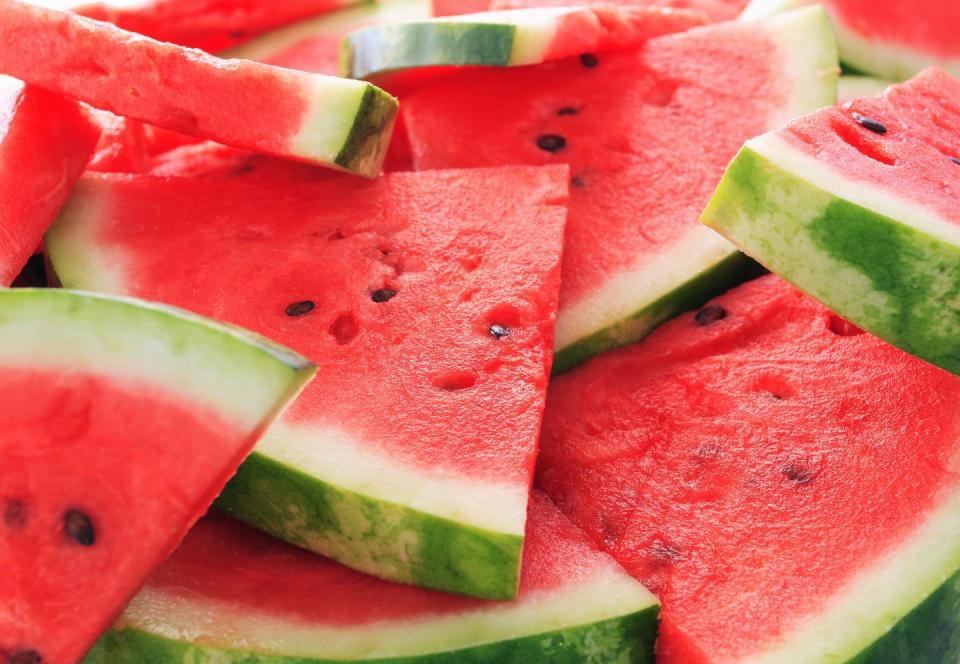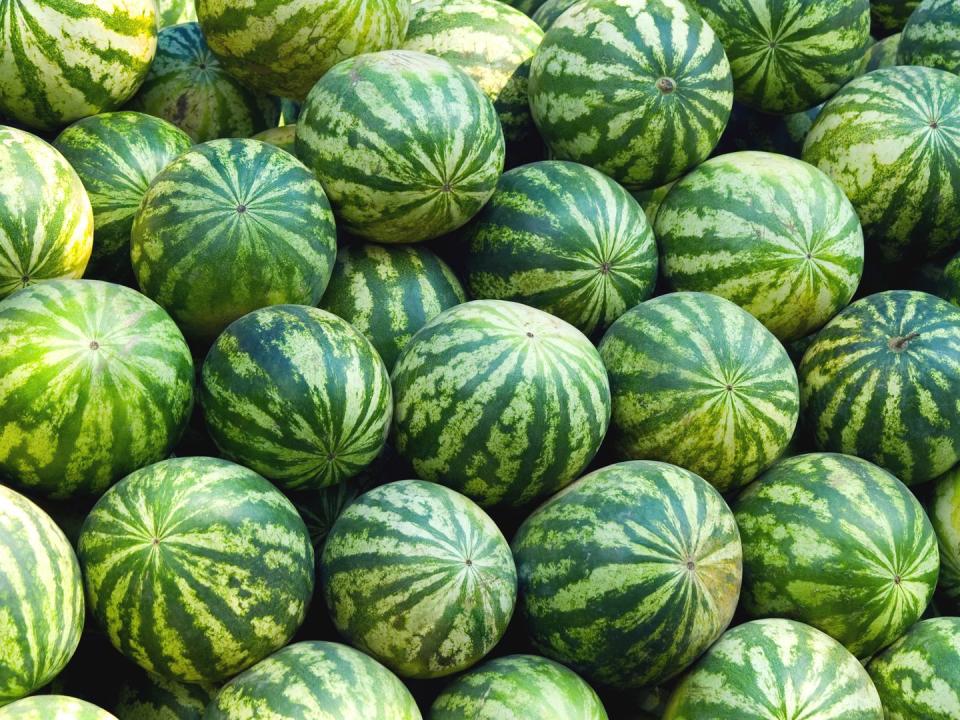Here’s What You Need to Know to Pick the Perfect Watermelon

The picture-perfect summer day can vary from person to person, but there's one common denominator in every sunny scenario: a juicy, red slice of watermelon! Whether you're floating on an inflatable flamingo in the pool, picnicking in the park, or partying at a potluck, adding a cooling bite of watermelon to the mix is the best way to kick the summer vibes into high gear.
While it's undeniably delicious when consumed raw in wedge form, there are also so many watermelon recipes to make for a creative way to cool down. Toss watermelon in a big bowl with cucumbers and feta for a semi-sweet summer cookout side, or mix its juice with your favorite liquor to make a refreshing watermelon drink. You can even grill watermelon for a smoky and sweet treat!
But before you start experimenting with watermelon in the kitchen, the first step is learning to pick one that's ripe and juicy! Peak watermelon season runs from May to August in the United States, so you'll want to read up on all the melon material you can find before summer to ensure you get the sweetest of the bunch! These tips on how to pick a watermelon apply to so many scenarios, whether you're physically plucking one from a watermelon patch or your backyard garden or choosing one at a grocery store or farmers' market.
So, if you want to avoid mushy melon, follow these tips on how to choose the best watermelon from Jordan Carter, past president of the National Watermelon Promotion Board and vice president of sales and marketing at Leger & Son, Inc., watermelon growers in Cordele, Georgia.

How do you pick a good watermelon?
Look, lift, and turn the melon so you can inspect all sides, says Carter. It's best to avoid buying any watermelon that has cuts, dents, soft spots, or bruises. Most importantly, look for the ground spot—the area where it sat on the ground as it ripened. "You want it to be a creamy or buttery yellow color," Carter says. "If it's white or green, it was harvested too soon before it was ripe and may not taste sweet."
Can you thump a watermelon to see if it's ripe?
Some folks swear by this method: If you thump the rind of a watermelon and it sounds hollow, then it's ripe, juicy, and ready to eat; if the thump produces a higher-pitch ringing sound, it's underripe; then if you just hear a thud, it's overripe.
Another ripeness test that people often mention is picking up a watermelon to see if it feels heavy. So theoretically, you could even pick up two watermelons of similar size and see if one feels heavier than the other.
Do either of these methods guarantee a juicy, sweet, ripe watermelon? Of course not. The only way to know if a watermelon is truly sweet and flavorful is by taking a big bite! But these tricks work for many and might be worth trying!
Wash your watermelon before cutting it up.
It's fine to let your watermelon sit on the counter for a few days; it will last a few weeks on your counter at room temperature, says Carter. When you're ready to cut into it, rinse it with cool water, scrub it with a stiff brush, and dry it off with a paper towel before slicing. This is an important step that a lot of people skip, but watermelon grows in soil and you don't want to drag any microbes from the skin into the flesh with your knife! Once cut, watermelon lasts about three days in the fridge before quality deteriorates. An average 15 to 20-pound watermelon will yield about 11 cups of cubes.
How can you tell if a watermelon is sweet?
Unfortunately, the only surefire way to know is by cutting into one. But choosing a watermelon with the yellow ground spot helps because you know it was harvested when the melon was ripe. Also, the sugar content can vary depending on the variety grown and weather conditions that year. For example, in extremely rainy years, the watermelon may absorb too much rain and taste bland, says Carter. But keep trying! The next one may be sweet and delicious.
What's better: seeded or seedless watermelons?
It's really a matter of personal preference, says Carter. Some people love the nostalgia of the seeded varieties, but many others prefer no seeds. Ditto with round versus oval or solid-colored versus striped watermelons; they're different varieties, but there's no advantage to choosing one type over the other.

What is that hole in the center of a watermelon?
Sometimes you cut open a melon and find a gap or three-pointed hole, known as "hollow heart" right in the center of your watermelon. These cavities form inside the fruit, usually in seedless melons, due to inadequate pollination by bees because of unfavorable weather conditions, low bee numbers, or an inadequate supply of pollinator plants. There's absolutely nothing wrong with the melon, and it's totally fine to eat; it's just a little imperfect in appearance, says Carter.
What is the webbing on a watermelon?
Despite its unappealing name, webbing on a watermelon can actually be a good thing! 'Webbing' refers to the course, web-like, brown scuffs on the rind (green outer skin) of the watermelon. These brown spots are scars from pollination, so the more webbing there is, the more times a bee pollinated the watermelon as a flower. And, in turn, the more pollination, the sweeter the fruit! So, if you see these imperfections on a melon at the store, don't toss it to the side, as there's a good chance it's extra sweet!
How do you know when a watermelon is ready to pick from your garden?
Most watermelon varieties take from 80 to 90 days to mature. In addition to looking for the creamy or buttery ground spot, the rind will turn from shiny to a more matte or dull appearance, and the green tendrils and main vine will turn brown. Use a knife to cut through the stem. Now you're ready to enjoy your homegrown watermelon!
You Might Also Like

